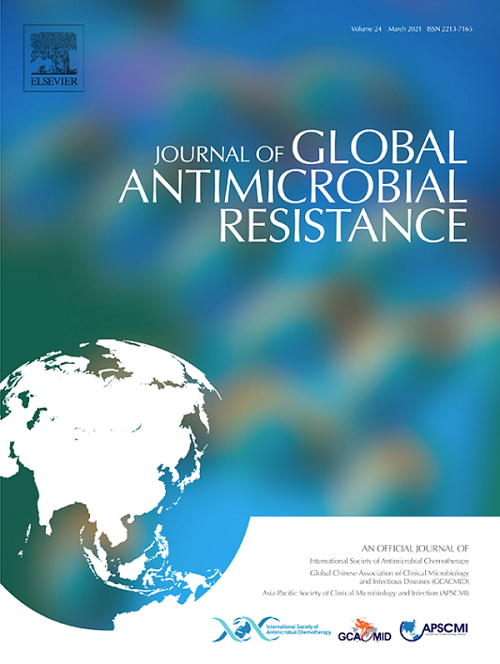多药耐药低毒力拟肺炎克雷伯菌ST1859-KL35亚种的鉴定共携带tmexd2 - toprj2和blaKPC-2的相似肺炎菌株。
IF 3.7
3区 医学
Q2 INFECTIOUS DISEASES
引用次数: 0
摘要
目的:多药耐药肺炎克雷伯菌的上升是一个重大的公共卫生威胁。准肺炎克雷伯菌常被误认为肺炎克雷伯菌,其遗传和毒力特性仍未得到充分研究。本研究表征了一种准肺炎克雷伯菌亚种的基因组和表型特征。方法:采用微肉汤稀释法进行药敏试验。通过血清杀灭试验和建立大卖场菌感染模型评价毒力。全基因组测序(WGS)和生物信息学分析确定了序列分型、抗性谱和质粒类型。偶联分析评估了质粒的可转移性,而系统发育分析则探讨了遗传关系。结果:KP24表现出耐多药表型,包括对碳青霉烯类、头孢他啶/阿维巴坦和替加环素耐药。与ATCC700603相比,KP24的血清存活率和大麦香杆菌致死率显著提高,但毒力低于高毒力菌株NUTH-K2044。WGS鉴定KP24为ST1859和KL35,携带有氧肌动蛋白毒力基因簇(iucABCDiutA)和多个耐药基因,包括tmexd2 - toprj2、blaKPC-2、blaOXA-10、blaIMP-4和qnrS1。值得注意的是,tmexCD2-toprJ2和blaKPC-2基因位于同一质粒(pKP24-1)上,这是一种罕见的共存现象。偶联实验证实pKP24-1可独立转移至大肠杆菌J53。系统发育分析表明,ST1859与ST334亲缘关系密切,具有明显的单枝进化特征,遗传多样性较低,具有区域扩张和全球传播的潜力。结论:KP24是一株低毒力但耐多药的拟肺炎克雷伯菌亚种。类似肺炎,具有令人担忧的毒力和耐药性决定因素的组合。tmexCD2-toprJ2和blaKPC-2在可转移质粒上的共定位突出了关键抗性机制的水平基因转移的潜力。本文章由计算机程序翻译,如有差异,请以英文原文为准。
Characterization of a multidrug-resistant hypovirulent ST1859-KL35 klebsiella quasipneumoniae subsp. similipneumoniae strain co-harboring tmexCD2-toprJ2 and blaKPC-2
Objectives
The rise of multidrug-resistant (MDR) Klebsiella pneumoniae is a significant public health threat. Klebsiella quasipneumoniae is often misidentified as K. pneumoniae, and its genetic and virulence traits remain underexplored. This study characterizes the genomic and phenotypic features of a K. quasipneumoniae subsp. similipneumoniae strain (KP24).
Methods
Antibiotic susceptibility was tested using microbroth dilution assay. Virulence was evaluated through serum killing assay and Galleria mellonella infection model. Whole genome sequencing (WGS) and bioinformatics analysis determined sequence typing, resistance profiles, and plasmid types. Conjugation assays assessed plasmid transferability, while phylogenetic analysis explored genetic relationships.
Results
KP24 exhibited an MDR phenotype, including resistance to carbapenems, ceftazidime/avibactam, and tigecycline. KP24 showed significantly higher serum survival and G. mellonella lethality than ATCC700603, though it was less virulent than the hypervirulent strain NUTH-K2044. WGS identified KP24 as ST1859 and KL35, harboring the aerobactin virulence gene cluster (iucABCDiutA) and multiple resistance genes, including tmexCD2-toprJ2, blaKPC-2, blaOXA-10, blaIMP-4, and qnrS1. Notably, the tmexCD2-toprJ2 and blaKPC-2 genes were located on the same plasmid (pKP24–1), an uncommon co-existence. Conjugation assays confirmed the independent transferability of pKP24–1 to Escherichia coli J53. Phylogenetic analysis revealed that ST1859 forms a distinct monoclade with low genetic diversity, closely related to ST334, suggesting regional expansion and potential global dissemination.
Conclusions
KP24 represents a hypovirulent yet multidrug-resistant strain of K. quasipneumoniae subsp. similipneumoniae, with a concerning combination of virulence and resistance determinants. The co-location of tmexCD2-toprJ2 and blaKPC-2 on a transferable plasmid highlights the potential for horizontal gene transfer of critical resistance mechanisms.
求助全文
通过发布文献求助,成功后即可免费获取论文全文。
去求助
来源期刊

Journal of global antimicrobial resistance
INFECTIOUS DISEASES-PHARMACOLOGY & PHARMACY
CiteScore
8.70
自引率
2.20%
发文量
285
审稿时长
34 weeks
期刊介绍:
The Journal of Global Antimicrobial Resistance (JGAR) is a quarterly online journal run by an international Editorial Board that focuses on the global spread of antibiotic-resistant microbes.
JGAR is a dedicated journal for all professionals working in research, health care, the environment and animal infection control, aiming to track the resistance threat worldwide and provides a single voice devoted to antimicrobial resistance (AMR).
Featuring peer-reviewed and up to date research articles, reviews, short notes and hot topics JGAR covers the key topics related to antibacterial, antiviral, antifungal and antiparasitic resistance.
 求助内容:
求助内容: 应助结果提醒方式:
应助结果提醒方式:


